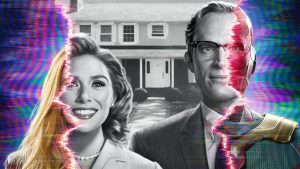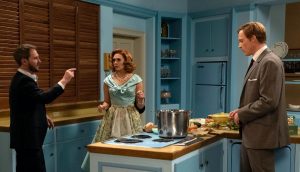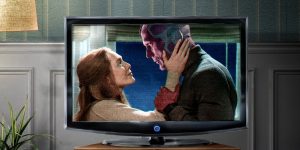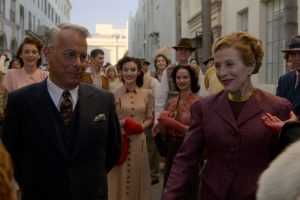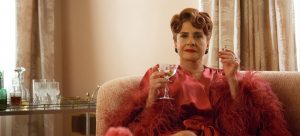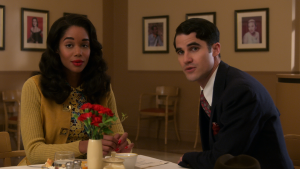I don’t usually write recaps. I mean, in some ways, all movie and TV reviews are just overly-detailed recaps embellished with a lot of flowery prose, but this is still pretty new ground for me. But it’s 2021, WandaVision is on its way to Disney+ in less than two weeks (!), and it’s time to try my hand at writing a comprehensive recap of Wanda Maximoff’s journey in the Marvel Cinematic Universe thus far. The timing of this post is in no way meant to deliberately precede the official Marvel recap that is set to be released shortly before the series premiere…okay, well, maybe it is: but only a little (ask yourself honestly, who would you trust to give you the most detailed information on Wanda Maximoff? The studio responsible with actually overseeing her character arc, or me?).

The purpose of any good recap is to muster up more hype (as if we could be any more hyped for WandaVision at this point), and to help give audiences – particularly newcomers to any given franchise – an idea of what’s come before, and what to expect. But I’ve realized that a good recap can also be helpful to me as a reviewer, because its existence means I don’t have to put as much exposition and background information into my actual reviews: I can jump straight into the action, while simply linking back to this recap. And now that we’re all up to speed, let’s get into it, shall we?
Wanda Maximoff’s MCU journey began in 2013, in the post-credits scene to Captain America: The Winter Soldier, where she and her twin brother Pietro Maximoff first appeared as haggard, world-weary lab experiments trapped in a frigid Eastern European fortress under the supervision of Baron Von Strucker, a nefarious scientist working with the covert Neo-Nazi organization, HYDRA. Von Strucker and HYDRA are largely unimportant to the story of the Maximoff twins except insofar as they allowed the twins access to the Mind Stone, one of the six Infinity Stones that preserve the integrity of the universe itself, as part of a larger attempt to use the Stone’s power to artificially enhance human beings into superhuman killing machines. What exactly happened during this series of experiments is still unknown: but by the time they left Von Strucker’s fortress, Pietro had super-speed, and Wanda was a dangerously unpredictable sorceress equipped with telekinesis, telepathy, and reality-altering magic. The fact that these aren’t powers one would typically associate with the Mind Stone’s sphere of influence, and the fact that Pietro and Wanda are two of the most notable mutants in the pages of Marvel Comics, has always suggested to fans that there’s something more going on here than Marvel has yet revealed.
This wouldn’t surprise me: even if the MCU wanted to retroactively confirm that Wanda and Pietro are both mutants (and I think they very much want to), they couldn’t have done so until just recently, when Disney bought out 20th Century Fox and thus obtained the rights to the Marvel mutants and Fantastic Four. Mutants are characters born with latent superhuman abilities that typically manifest themselves at the onset of puberty, with catastrophic results. In the comics, Wanda and Pietro are not only prominent mutants, but the children of telekinetic mutant terrorist Erik Lensherr, a.k.a. Magneto, one of the most famous comic-book villains of all time. But what about MCU Wanda and Pietro? The MCU has conveniently left the twins’ backstory vague: their parents supposedly died during a period of civil unrest in their hometown of Sokovia, but we don’t know that for sure, and we still don’t know their parents’ names. Additionally, it appears that Wanda and Pietro were the only test subjects who survived being exposed to the Mind Stone’s raw power: something that immediately suggests they at least had superhuman levels of endurance prior to the experiment. A recent Marvel tie-in book hinted that Wanda’s powers were “unlocked” by the Mind Stone. And footage from the recent WandaVision trailer shows a possible flashback to Wanda’s first encounter with the Stone, so I believe we’ll finally get a conclusive answer to this question that has long divided the fandom.
By 2014, Wanda and Pietro were strong enough to take on the Avengers during the siege of Sokovia. While Pietro wasted his time running rings around Hawkeye of all people, Wanda confronted Tony Stark himself and sent him into a prophetic trance: a neat trick, and one with major consequences – as Tony saw visions of his friends slaughtered by aliens, and became so obsessed with the idea of building “a suit of armor around the world” that he took the Mind Stone and implanted it into a weaponized supercomputer he named Ultron. The Mind Stone caused Ultron to come to life and quickly grow hostile towards his maker, irrationally arriving at the conclusion that to protect the human race, he had to…wipe them out with a meteor. Ultron brought the newly liberated Maximoff twins under his wing, while designing a humanoid synthetic body for himself – which the Avengers stole from him and into which they implanted Tony Stark’s A.I. personal assistant J.A.R.V.I.S., before using the Mind Stone to bring their creation to life. Thus, Vision was born: and his ability to live inextricably tied up with the Mind Stone, and its fate.

Wanda and Pietro betrayed Ultron during the second battle of Sokovia, in which Ultron tried to uproot the city from the planet’s surface and use it as his meteor. Pietro, sadly, was killed while protecting Sokovian citizens, and Wanda – sensing his death from afar – unleashed a tidal wave of chaos magic that tore through Ultron’s robot army: saving the day at a terrible personal cost. She herself killed Ultron, tearing out his heart and crumpling it into a tiny ball of shrapnel, just to give him some idea of how she’d felt. It was Vision, however, who put an end to the robot once and for all, laser-beaming him out of existence. Both Wanda and Vision officially joined the Avengers team soon afterwards, and started developing feelings for each other.
When Captain America: Civil War rolled around in 2016, Wanda had dropped her vaguely Eastern European accent and acclimated to life as an Avenger. But not enough, apparently, to know that telekinetically flinging a suicide-bomber into the side of an office building maybe isn’t a great idea. Her actions proved to be the catalyst of civil war, quickly dividing the Avengers into two camps: those led by Tony Stark, who believed that superheroes needed to be regulated to minimize civilian casualties, and those led by Steve Rogers, who believed such regulation would only introduce more risks. Wanda, still traumatized by what she had done and viewed as emotionally unstable, was forced to stay back at headquarters under Vision’s surveillance. The two bonded over their foodie interests, but it wasn’t long before Wanda realized she was being confined and escaped with the help of Hawkeye, battling Vision on her way out.
The film’s third act pitted Wanda and Vision against each other again, but this time Wanda was ultimately arrested and taken to The Raft, a maximum-security submarine prison. From the time Steve Rogers arrived to break her out at the end of the film, to the time we reunited with her and Vision in Avengers: Infinity War, her life is a blur. On the run from most of the world’s governments and still regarded as one of the most dangerous Avengers, she went undercover, made up with Vision, and eloped with him to Glasgow, Scotland, where the two were still enjoying their honeymoon phase when Thanos’ minions arrived to kill them both. She (or possibly Vision himself: it’s hard to say) also discovered a way to disguise the android as a human being, a technique that will be reused for WandaVision, where the duo must pass for an average suburban couple.
But even as they were enjoying their romantic getaway, Thanos was assembling his Infinity Gauntlet, which required all six Infinity Stones to achieve full power. The Mad Titan dispatched his Black Order to retrieve the two Stones that remained on earth: one of which, the Mind Stone, was still embedded in Vision’s skull. Although the Black Order’s efforts were initially repelled, Wanda and the Avengers were forced to head to Wakanda to find scientists capable of separating the Mind Stone from Vision and destroying it without killing Vision in the process. It was hinted that this would have been possible, and Princess Shuri was already well underway with the process when the Black Order attacked again, but we may never know for sure unless this subject is brought up in WandaVision. Vision fled from Shuri’s lab with the Black Order in pursuit before the operation was complete, by this point realizing that the only way to render the Mind Stone unusable by Thanos was to have Wanda herself destroy it – and in so doing, Vision. The most heartbreaking scene in the film saw Wanda holding back Thanos with one hand while using the other to unmake the Mind Stone, all while staring into Vision’s eyes, never once losing sight of the man she loved. She was successful; Vision’s head exploded in a burst of light; and for a moment, audiences could breath a sigh of relief, assured that Thanos’ defeat was imminent.
But Thanos had already recovered the Time Stone from Doctor Strange, millions of light years away. He used that Stone’s powers to resurrect Vision, giving the android a few more moments to live before brutally ripping the Mind Stone out of his forehead, killing him again. Wanda’s pain at losing her lover twice in a span of seconds, at her sacrifice being all in vain, must have been devastating: it’s easy to understand why, when Thanos completed his Gauntlet and snapped his fingers, killing half of all living creatures including Wanda herself, she embraced death willingly.
But five years later, when Bruce Banner used a reconstructed version of the Gauntlet to snap half of all life back into existence, Wanda was one of those most eager to exact her vengeance on Thanos. Out of Avengers: Endgame‘s many highlights, the vicious duel between Wanda and Thanos stands out to me because of how deeply personal it is for Wanda – and because of how satisfying it is to see her go absolutely wild in that moment, caring nothing for mercy, controlled only by bloodlust. In a universe where many heroes are driven by some moral code, Wanda is refreshing in that she doesn’t have any code. She’s witnessed too much pain and human failure to believe in the unconquerable power of good. So when she singles out Thanos, she doesn’t waste a moment trying to rip him limb from limb: and she nearly succeeds, though Thanos is eventually able to catch her off-guard with a barrage of missiles.

With her part in the battle complete, Wanda quietly disappeared under the radar. Last time we saw her, she was one of many heroes in attendance at Tony Stark’s funeral, and had a brief but touching conversation with Hawkeye on the subject of grief and memory. She seemed to be at peace: but we know from the WandaVision trailers that in the aftermath of Endgame she will be lured into an alternate reality where she and Vision are able to live happily ever after, with a house, friendly neighbors, and twins of their own. Modeled off the classic American sitcoms from which Wanda learned English, this utopian dreamscape is being manipulated by dark supernatural forces, and infiltrated from the real world by S.W.O.R.D. agents trying to rescue Wanda.
Has my recap been helpful? And what are you most excited for in WandaVision? Share your own thoughts, theories, and opinions, in the comments below!
